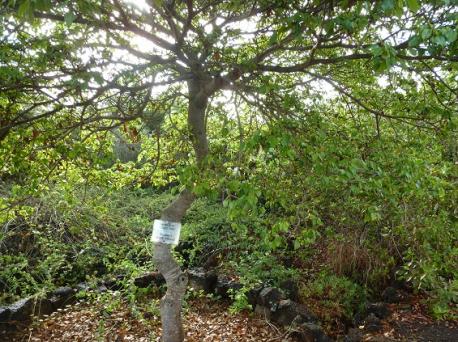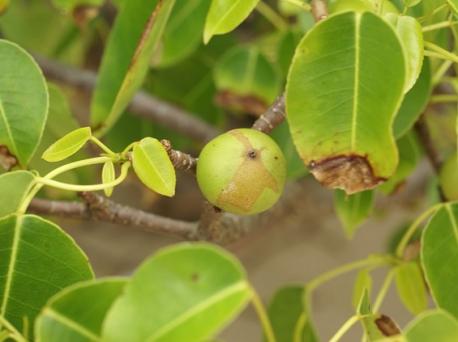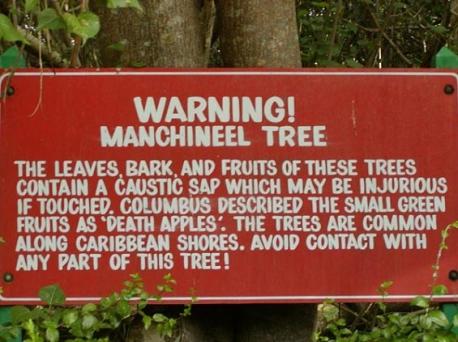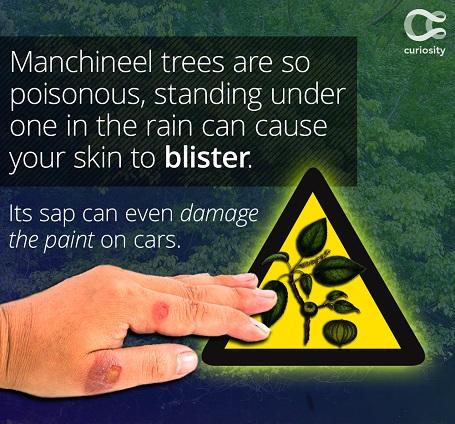Results: The Manchineel (the most dangerous tree in the World)
Published on 05/27/2017
QUESTIONS
GO to COMMENTS
Comments
1.
1.
The manchineel tree is a species of flowering plant in the spurge family. It is native to tropical southern North America and northern South America. The name "manchineel" (sometimes written "manchioneel") as well as the specific epithet mancinella is from Spanish manzanilla ("little apple"), from the superficial resemblance of its fruit and leaves to those of an apple tree. A present-day Spanish name is in fact manzanilla de la muerte, "little apple of death". This refers to the fact that manchineel is one of the most dangerous trees in the world. Manchineel is also known as the beach apple. Are you familiar with the manchineel tree (or "little apple of death")?

Yes
10%
161 votes
No
90%
1525 votes
2.
2.
What facts are you familiar with?

Manchineel is native to the Caribbean, the U.S. state of Florida, The Bahamas, Mexico, Central America, and northern South America.
5%
86 votes
The manchineel tree can be found on coastal beaches and in brackish swamps where it grows among mangroves. It provides excellent natural windbreaks and its roots stabilize the sand, thus helping to prevent beach erosion.
6%
94 votes
The evergreen manchineel tree, grows up to 15 metres (49 ft) tall. It has reddish-greyish bark, small greenish-yellow flowers, and shiny green leaves. The leaves are simple, alternate, very finely serrated or toothed, and 5–10 cm (2–4 in) long.
4%
71 votes
Spikes of small greenish flowers are followed by fruits, which are similar in appearance to an apple, are green or greenish-yellow when ripe. The fruit is poisonous.
4%
66 votes
Despite the inherent dangers associated, the tree has been used as a source of timber by Caribbean carpenters for centuries. It must be cut and left to dry in the sun to remove the sap. A gum can be produced from the bark which reportedly treats edema, while the dried fruits have been used as a diuretic.
3%
44 votes
The manchineel tree is listed as an endangered species in Florida (USA).
2%
33 votes
All of the above.
3%
53 votes
N/A or I am unfamiliar with all of these facts.
84%
1422 votes
3.
3.
The toxicity of the manchineel tree, what toxin facts are you familiar with?

All parts of the tree contain strong toxins, some unidentified. Its milky white sap contains phorbol and other skin irritants, producing strong allergic dermatitis. Standing beneath the tree during rain will cause blistering of the skin from mere contact with this liquid (even a small drop of rain with the milky substance in it will cause the skin to blister).
6%
99 votes
The sap has also been known to damage the paint on cars. Burning the tree may cause ocular injuries if the smoke reaches the eyes. Contact with its milky sap (latex) produces bullous dermatitis, acute keratoconjunctivitis and possibly large corneal epithelial defects.
6%
97 votes
The fruit is possibly fatal if eaten; however, "fatalities from ingestion are not reported in the modern literature" and "ingestion may produce severe gastroenteritis with bleeding, shock, bacterial super-infection, and the potential for airway compromise due to edema.
4%
70 votes
When ingested, the fruit is reportedly "pleasantly sweet" at first, with a subsequent "strange peppery feeling, gradually progress[ing] to a burning, tearing sensation and tightness of the throat". Symptoms continue to worsen until the patient can "barely swallow solid food because of the excruciating pain and the feeling of a huge obstructing pharyngeal lump."
2%
41 votes
In some parts of its range, many trees carry a warning sign (for example on Curaçao), while others are marked with a red "X" on the trunk to indicate danger. In the French Antilles the trees are often marked with a painted red band a few feet above the ground.
2%
37 votes
While the plant is toxic for many birds and animals, the black-spined iguana (Ctenosaura similis) is known to eat the fruit and even live among the limbs of the tree.
1%
23 votes
All of the above.
3%
53 votes
N/A or I am unfamiliar with all of these toxicity facts.
84%
1413 votes
4.
4.
Lastly, do you have any of these manchineel trees in the area where you live?

Yes
5%
82 votes
No
76%
1277 votes
Undecided
19%
327 votes
COMMENTS


